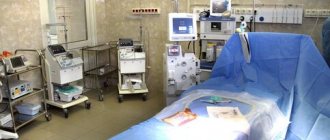Autism: what is it?
Autism is a disorder of psychological as well as mental development.
The disease is accompanied by a pronounced lack of emotional expression and lack of desire to communicate. The word “autism” itself is translated as a person who withdraws into himself. Thus, patients suffering from this disease are prone to carrying out actions that lack social meaning. Also, these people never show emotions, and there are no gestures in their interactions with others. Early childhood autism is diagnosed in preschool children. The initial symptoms of the disease, as well as the characteristics of its manifestation, depend on the form of the pathology. Most often, at the initial stage, the pathology is accompanied by disturbances in speech, gestures, and facial expressions during communication.
Causes, symptoms and signs of the disease
Autism entails a delay in the patient’s full mental development. More often than not, these children do worse than their peers at school. The disease affects the ability of an autistic child to concentrate and remember learned material.
Profound mental retardation is possible in those children whose autism was caused by other severe diseases of the brain or nervous system. The main feature of autism is selective intelligence. The fact is that some autistic people may excel in music or art, but fall significantly behind in other subjects. An example of this would be some famous figures in history who made significant contributions to science, such as Albert Einstein, who was also autistic.
It is impossible to determine externally whether a child has a disease such as autism. The exact causes of such a disorder of the nervous system are not fully known, but several main provoking factors have been named:
- Obesity and other maternal metabolic disorders.
- Cerebral palsy.
- Oxygen starvation of a child during pregnancy or childbirth.
- Infectious diseases that the mother suffered while pregnant.
- Hereditary predisposition.
Making an accurate diagnosis is possible only after a complete examination of the child. It is possible to suspect early autism if you pay attention to the child’s behavioral characteristics. Pathology is possible under the following conditions:
- the child likes to play alone and does not show a desire to communicate with others;
- cannot tolerate loud noises;
- shows nervousness when touched by others;
- always looks away when adults talk to him;
- is more often silent, does not know how to clearly explain what he wants;
- throws frequent tantrums;
- the child lacks the instinct of self-preservation.
In addition, early autism can be suspected in a passive or hyperactive child if there are additional signs of the disease listed above.
Autism or not autism?
CONSULTATION WITH A PSYCHOLOGIST
231-22-80; 231-22-87; 993-22-48.
In the book edited by Doctor of Psychological Sciences N.L. Belopolsky autism is defined as a complete or partial refusal to communicate with others.
How not to confuse autism with other types of mental development disorders? Let's go over the concepts.
Mental retardation is a lag behind the level of development that is considered normative. With mental retardation, one can observe a lag in intelligence, accompanied by a violation of the emotional-volitional sphere and psychomotor skills. A norm is a kind of standard developed on the basis of the diagnosis of children selected for similar characteristics (in layman's language - “average temperature in the hospital”).
Developmental delay is considered a temporary phenomenon, which is compensated by the end of primary school (approximately 4th grade, but can persist until adolescence - 12, 13 years).
Mental retardation is a generalized definition of a complex of disorders of higher mental functions: perception, thinking, attention, memory, speech. Mental retardation can develop against the background of hyperactivity (the child’s inability to concentrate, hyperexcitability slows down the process of his learning and development), and can be expressed in the slowness of the child’s reactions, apathy, lethargy of facial expressions and reactions to external stimuli.
A diagnosis of “mental retardation” can be given to a child at PMPK at the end of primary school if the level of development of his mental functions has not reached standard indicators.
Until the end of primary school, neither PMPK specialists, nor school administration and teachers have the right to insist on a diagnosis of “mental retardation” or “autism” (unless, of course, we are initially dealing with a severe case, such as a mental disorder, complete social helplessness, lack of understanding of what is happening). Early diagnosis takes place if parents plan to apply for disability in order to receive social benefits and pensions.
Moreover, such children have all the rights to study in a regular school according to an individual curriculum (this does not require any special certificate, change of diagnosis or transfer to home schooling). In this case, the child is taught in a class with other children, but on an individual educational route; a certain percentage of school disciplines are taught to the child in an individual format. This is established by the Federal State Educational Standard and the federal law “On Education in the Russian Federation”.
Autistic traits in the form of partial refusal to communicate, ritualism, and phobia can also appear in a child with mental retardation, hyperactivity and mental retardation, but they cannot be called autistic.
For example, ADHD (attention deficit hyperactivity disorder) can be confused with Asperger's syndrome (a mild form of autism).
Here are their common features:
- difficulty establishing long-term contact with children and adults;
- inability to understand other people's feelings;
- prolonged repetition of certain actions;
- psychological problems that arise with any change in schedule or regime;
- frequent repetition of the same words or entire phrases (echolalia);
- literal understanding of any idiomatic expressions;
- clumsiness of movements;
- restless sleep, increased anxiety;
- fear of novelty;
- motor impairment;
- delayed development of communicative speech;
- intelligence close to average, average or above average;
- this syndrome occurs only in boys (girls have attention deficit, but without hyperactivity).
Hyperactivity is classified as minimal brain dysfunction (MCD).
MMD is characterized by behavioral disturbances from mild to severe degrees, combined with minimal deviations in the central nervous system, which can be characterized by various disturbances of perception, speech, attention, memory, and motor functions.
Scientists have found that combining sugar with carbohydrates leads to increased activity in children with ADHD.
A hyperactive child can be distinguished from a child with Asperger's syndrome by excessive activity - even if such a child sits calmly on a chair (as calm as he can be), he still seems to be shocked from within, he is tense to the limit and every now and then, his energy is not endures and bursts out like a geyser, accompanied by muscle tics, screaming and even laughter. They get bored with any activity, even an interesting one, after 10 minutes (unlike an autistic person who can spend hours doing the same type of activity).
Hyperactive children are very impressionable, with a rich imagination (it is believed that children with Asperger syndrome do not know how to fantasize and have problems with abstract thinking (this is compensated with age). “Hypers” constantly have different images in their heads that they can’t wait to depict with sound or on paper, build something, etc. I know a child who, for example, perfectly copies the conversation between whales and dolphins.
Such children have very developed acting abilities, developed facial expressions, and an articulatory apparatus. In an autistic person, facial expressions are poorly expressed.
Hyperactive children may love reading or math. As a rule, they begin to read or write earlier than their peers, and they can write words of any complexity without errors, but due to problems with fine motor skills, handwriting turns out to be sloppy and needs correction. By the way, many geniuses have bad handwriting and are indifferent to order, just like hyperactive guys. Chaos for them is their native element. A hyperactive child is controlled by the word “I want.” If he wants something, it becomes the center of his Universe and everything else fades into the background. That's why they often have big problems with their studies.
Children with Asperger's syndrome are talented in their own way. They have amazing powers of observation and can notice details invisible to the eyes of an ordinary person; they have a phenomenal memory. Such children make excellent programmers, artists, cartographers, and designers. Although talented in some narrow areas, they may show illiteracy in others (some people even in adulthood cannot write well, have difficulty reading, and can only learn with the help of videos, pictures, and signs).
Often such children are perceived by others as eccentrics because of their strange behavior. They have many brilliant ideas, but it is difficult for them to implement them without outside support, they are helpless in everyday life and remain introverts until the end of their lives, having only a narrow circle of contacts and interests.
There are various theories in determining the causes of ADHD:
- Supporters of neurobiological theories believe that such children have a problem in the production of the hormone serotonin, which affects behavioral disorders and metabolic disorders;
- Proponents of neuropsychological theories believe that the whole point is a violation of the inhibition mechanism in the brain;
- Neuroanatomical theory supports the hypothesis of frontal lobe dysfunction, which is not sufficiently confirmed, as well as...
- theory of toxic substances (the effect of food additives, salicylates, sugars, lead). These theories require additional research.
The formation of hyperactivity or mental retardation can be influenced by factors such as prematurity, hypoxia during pregnancy or childbirth (umbilical cord entanglement), heredity, environmental disadvantage, environmental factors, including upbringing.
The presented psychological disorders are comorbid, i.e., they may be accompanied by symptoms of other disorders (a child with ADHD and mental retardation may have autistic symptoms, various types of neuroses). Therefore, until the end of primary school, one cannot insist on any certainty when making a diagnosis; one can only make assumptions. No one knows how a child will perform in a few years. It happens that children with serious disabilities, with a competent approach, show a big leap in development!
Read more about the treatment of children with ADHD in my article https://www.b17.ru/article/72836/
How is autism different from the above-mentioned psychological dysfunctions? Let me give you some features:
- obsessive ritualism and fixation on some action. A child always goes to school the same way, can perform the same action for hours, for example, rearranging objects from place to place, pouring water from one container to another (unlike the “hyper”, who quickly gets bored with everything). for impaired function of attention and concentration);
- poor facial expressions: often an empty, expressionless look;
- panic fear of everything new (rearranging the furniture in the room of a child with autism can cause real horror and strong protest in him);
- lack of emotional reaction to family members and even protest when a parent tries to hug him. A hyperactive child may also have difficulty making contact with other people, but more due to the inability to establish communication, however, he loves to play with his parents, brothers and sisters, and shows attention and affection to them;
- desire for schematism (understanding of a subject occurs mainly through diagrams and drawings);
- low intellectual level or intellectual disability. In 15-20% of cases, the intelligence of autistic people is preserved, but still suffers due to behavioral characteristics;
- autism may be more common in boys, but it also occurs in girls.
According to H. Asperger, the main cause of mental and behavioral disorders is the primary weakness of instincts, underdevelopment of internal speech, “central impairment of the processing of auditory impressions,” which leads to a blockade of the need for contacts. The cause of the disorder in the system of organizing and planning behavior in autistic people D.N. Isaev and V.E. Kagan is seen as a violation of the frontal-limbic functional connections of the brain.
There are also a number of scientific theories in determining the causes of autism:
- Emotional deprivation in early childhood (psychogenic origin of autism);
- Brain lesions (organic origin of autism);
- Genetic predisposition.
The effects of certain types of foods, additives, and lead also remain questionable and require additional research.
How to help children with emotional-volitional disorders?
- Drug therapy (prescribed by a psychiatrist);
- Behavioral therapy (teaching children social and self-care skills);
- Art therapy;
Walking in the fresh air, massage, exercise therapy, swimming, relaxation techniques, and prolonged stay in a state of joy and happiness have a beneficial effect. Unfortunately, some types of therapy may not be available to the child due to his/her characteristics (phobias). But you can always choose the type of therapy that is comfortable for him.
Parents need to remain optimistic and in a good mood no matter what, because... The bad mood of others is very harmful to the psychological development of the child.
Parents, remember - in every difficulty lies an opportunity! The opportunity, despite everything, to prove to yourself and others that you are capable of making your child a full-fledged member of society.
But don’t rush to draw conclusions; it’s better to consult a specialist first!
Source: https://www.b17.ru/article/75156/
How does autism manifest?
The disease manifests itself in the appearance of characteristic symptoms that can be detected already in the second year of the baby’s life.
Isolation from others
Parents may suspect a mild disorder of the nervous system if the child does not respond to an adult’s speech, always looks away, and does not look at the person who is addressing him. The child may laugh for no apparent reason or, conversely, will not even smile at any attempt by an adult to make him laugh.
Tries to communicate only with gestures, and does this only if there is a need to indicate to an adult his desires or needs.
He is not at all interested in communicating with his peers, and he is also unable to find contact with other kids, so he prefers to spend time alone. Such a child loves to play alone, and if another child tries to join him, he will most likely throw a tantrum or be capricious.
An additional difference between an autistic child is the lack of ability to play any role-playing games. He cannot come up with a plot for the game, and he perceives any toy completely differently, for weeks healthy children. For example, a child may be interested only in a specific part of a toy; he may spend hours looking at a wheel from a car and will not even think that this item can be used in another way, for example, rolled on the floor.
Even though a child with autism is unable to express emotions, he will still become anxious if his mother is out of sight.
Communication breakdown
Absolute absence of speech or delay in full development of speech are disorders that often occur in the youngest patients. The development of speech skills in such children depends on the severity of the disease. If a severe form of the pathology has been advanced, then the child may not begin to talk at all in the future. In some cases, patients learn to express their wishes and requests in short words. More often, speech is still present in such patients, but incoherent sentences are more like just a collection of random words.
Autistic children often have no reaction when called by name. They always talk about themselves in the third person. Their speech often does not make sense, and when asked a question, they can answer something that has nothing to do with you in the conversation.
Stereotypical behavior
This type of behavior includes:
- Daily rituals. Autistic children love to be in a familiar and comfortable environment. If any changes occur in their usual way of life, for example, rearranging furniture or moving, then they experience discomfort and anxiety. This can make a child withdraw into himself or cause him to become aggressive.
- Obsession, which manifests itself in concentrating on one activity. It is sometimes difficult to distract a child with autism from an activity to which he is willing to devote several hours.
- Intense fear. If a child often experiences stress, he may develop aggression not only towards others, but also towards himself.
- Repeated repetition of certain movements. If an autistic child finds himself in an unfamiliar environment or experiences stress, he begins to repeat the same movement over and over: swaying from side to side, fiddling with his fingers, or shaking his head.
Early symptoms of the disease
Parents may notice telltale signs of early autism in their child before he or she turns one. Children with this nervous system disease are inactive and show little or no interest in toys. Against the background of normal physical development, such children do not show a desire to learn new subjects.
Autism
This child development disorder appears in children at the age of 2 years, but the diagnosis can be confirmed later - at 3–5 years. Autistic people build their own little world and don’t want to leave it; they like to play completely alone and not communicate with anyone. The connection of such children with the outside world is disrupted, although they are quite healthy physically.
Signs of autism:
- isolation on oneself, avoiding people, not looking for friends;
- prefers to play alone;
- difficulties in verbal (speech, writing) and non-verbal (facial expressions, gestures, touch, assessment of appearance and voice) communication. Speech delay, mutism - random pronunciation of phrases and words;
- social interaction is impaired - lack of emotions for the actions of other people, leaves calls to him unanswered, does not look him in the eye, does not become attached to anyone;
- stereotypical behavior - the presence of certain mandatory rituals, repetition of the same type of movements for a long time, echolalia - repetition of words;
- may show aggression when trying to establish contact, screams;
- any changes taking place around him disturb him.
For some people (1-2 people), autistic children make an exception and can communicate with them.
The exact cause of autism has not been established, although many experts are inclined to believe it is genetic. Some believe that this pathology is caused by organic diseases of the brain.
Autistic people love music. With a mild form of the disorder, they can even surpass their peers in intelligence and study better, but only in some subjects, since their mental development is very selective. In addition, such people very often demonstrate outstanding abilities in certain areas (science, art) and can adapt quite normally in society with the right approach to upbringing, training and special correction.
Autistic disorders: types
There are several types of autistic disorders, which differ in severity and form of manifestation, and therefore require different methods of correction.
Asperger's syndrome
This is a mild form of the disease. The first symptoms begin to appear at about 7 years of age. Features of a child who has been diagnosed with this form of the disease:
- has a fairly high level of intelligence;
- speaks clearly, but loudly, has problems with intonation;
- self-centered, refuses to compromise;
- takes uncharacteristic postures and walks awkwardly due to lack of coordination;
- gets fixated on one thing.
Provided that favorable conditions for development and upbringing are created, a child with Asperger syndrome will be able to live a normal life in the future. Along with his peers, he is able to graduate from school and university, start a family, and get a job.
Rett syndrome
This is a consequence of abnormalities in the female chromosome, so the disease can only appear in girls. Boys who receive such a chromosome die during pregnancy. This syndrome is considered a severe form of the disease and occurs approximately very rarely, 1 time in 10 thousand children. The manifestation of pathology is accompanied by the following clinical symptoms:
- After birth, the child develops fully within a year, after which obvious signs of mental retardation begin to appear sharply.
- The rate of head growth after a year is significantly reduced, and impaired coordination of movements develops.
- Complete lack of speech.
- The child withdraws into himself, completely isolating himself from the outside world.
- Skills acquired before the age of one are lost.
- The child often makes meaningless repeated movements with his hands, as if washing himself.
This is a severe form of the disease, which is practically impossible to correct, so when diagnosed, in most cases the prognosis is unfavorable.
How a child behaves is a behavioral factor.
One of the main symptoms of autism and autism spectrum disorders is the child’s repetitive, that is, stereotypic behavior. Moreover, the child may be afraid of everything new.
Stereotypic behavior is expressed in repeated repetition of optional actions and movements. These can be rhythmic movements of the hands in the form of shaking or more complex actions and rituals.
In autism, aggression, fear, and protest reactions may not always be obligatory signs, although they occur quite often. The manifestations and signs of autism change somewhat with age, but persist throughout life.
There are pronounced stereotypes in behavior, activity and interests:
- Rocking in the crib for hours (a typical infant will quickly get bored with this activity, and after 10-20 minutes he will switch to something else)
- Children with ASD may constantly do the same strange actions for a long time, day after day: picking around, twisting the lid of a food jar
- Can press one button for a very long time, turn off the light, open and close a jar
- Showing interest in subjects that are unusual for one’s age
- Not interested in toys, but is delighted with household things - hair dryer, ladle
- Does not use his toys for their intended purpose - he bangs the cube on the floor, does not roll the car, but spins the wheels for a long time
The child moves in a special way:
- “Floats like a butterfly,” spins around its axis, waves its arms around itself.
- He sits and sways in one place for a long time.
- Walks on tiptoes.
Children with autism may have motor impairments. This is not a leading sign of autism when making a diagnosis:
- Children can be very clumsy, but at the same time they show wonders of balance by standing on one leg for a long time.
- They cannot master a bicycle or climb stairs.
- Fine motor skills are impaired—some children with autism have difficulty handling small objects.
Diagnosis of autism
Until one year is too early to talk about whether a child has a disease such as autism. Outwardly, at such an early age it is quite difficult to determine this pathology, however, experienced parents who already have older children may notice certain developmental deviations already at this age. If there are cases of autism in the family, it is important to closely monitor the child so that if characteristic symptoms of the disease are detected, medical assistance is provided in a timely manner. If the diagnosis is made as early as possible, then in the future the baby’s adaptation to the world around him will be simpler and more consistent.
Autism is diagnosed using the following basic methods:
- EEG is a research method necessary to make a diagnosis such as epilepsy. Sometimes autism can be suspected based on the fact that the patient experiences epileptic seizures.
- Examination by an otolaryngologist who tests the patient's hearing and confirms or excludes possible hearing loss.
- Brain ultrasound is a diagnostic method that can be used to identify or exclude the presence of disorders in the structure of the brain, which may lead to the appearance of symptoms of the disease.
- Testing using special questionnaires.
Impaired mental function
In this case, the child’s psychomotor skills, speech, emotions, thinking, attention, memory, etc. are below normal for his age. Such children are characterized by excessive lethargy; they have difficulty mastering the simplest skills - using a spoon, getting dressed. They begin to talk later, avoid peers and adults, and are unsociable.
ZPR, according to experts, is a passing phenomenon, and if measures are taken in time and the correct correction is carried out, then by the age of 10 it will completely disappear. The causes of this disorder: somatic diseases, including those of the expectant mother before and during pregnancy.
Is autism treatable in children?
Autism is a disease that cannot be completely cured, but thanks to effective correction methods, it is possible to help a child with this pathology adapt to the world around him. With close cooperation between the baby's parents and teachers, as well as routine actions, the child's condition can be significantly improved. The result of such efforts will be tangible successes of the baby in development and adaptation.
What parents of autistic children should know and always remember:
- Your child is special, not like other children.
- A favorable family environment is the key to a child’s full development. Frequent changes and stress are factors that can contribute to the deterioration of a child’s condition.
- Regular consultations with specialized specialists should not be neglected.
In young children, autism is treated in several stages, which include the formation of the patient’s skills necessary for existence in society, the gradual development of speech rudiments, observation and subsequent elimination of behavioral disorders. In addition, it is important for such children to be taught to play role-playing games and make eye contact when talking with an interlocutor.
There are several ways to correct autism:
- Speech therapy. A speech therapist is a specialist whose regular sessions are aimed at developing intelligible speech in a child, as a result of which the patient can construct sentences correctly.
- Behavioral. It is based on observation of the patient’s behavior, which is necessary to clarify the characteristics of the course of the disease and the subsequent method of correction.
- Medication. This method of correction is used extremely rarely and only in special cases. Neuroleptics, sedatives, and psychotropic drugs are prescribed to patients who have developed destructive behavioral disorders.
- Initially, children with autism do not have basic self-care skills. Such a child does not understand why he needs to bathe every day or wash his hands every time before eating. With the help of special classes with a specialist, the patient can be taught basic self-care skills, which occurs in a relaxed playful environment.
How to tell the difference?
It is sometimes simply impossible to distinguish between autistic children and children with mental retardation. For example, the former have learning difficulties similar to mental retardation, while the latter have a predilection for loneliness, as in autism. But there are features that will help you understand what kind of disorder it is:
| Child with mental retardation | Autistic |
| Difficulties with speech, embarrassed to speak | He speaks well (he can even outperform his peers in mastering speech), but only what he likes and often to himself. He may refuse to talk at all. |
| Doesn't know how to start conversations, but would really like to play with peers | Does not want to communicate, play with other children, does not suffer from loneliness at all |
| Panic at the appearance of any innovations, love of rituals | |
| Attached to family members, seeks their approval and affection | Emotional Indifference |
| Over time, with systematic exercise, it goes away completely. | Autism cannot be completely cured, you can only adapt to society |
The difference between oligophrenia and autism is quite clear, and there is hardly any need to describe it. Damage to areas of the brain cannot be corrected, so such a child should be perceived as he is.
Autism, if it is “pure”, is a completely conscious choice of the child. But children with mental retardation and mental retardation would like to be different, but they cannot. This is precisely the main difference.
Difference between autism and other diseases
Autism can easily be confused with some other diseases. If characteristic symptoms of pathology occur, you should not self-medicate; it is important to immediately seek advice from a specialist. Diseases that have similar clinical manifestations include:
- Schizophrenia. This mental illness is treatable, although its symptoms are very similar to autism.
- Hearing loss. This is a hearing impairment that can be either congenital or acquired. The disease causes poor development of the speech apparatus, as a result of which it is often initially confused with autism.
- Hyperactivity, in which the child does poorly in school due to restlessness and poor concentration.
- Delayed psycho-speech development also has similar symptoms to autism, but is easily corrected if you contact a specialist in a timely manner, who will prescribe a course of classes for the child.
Forecast
Autism is not as scary as it might initially seem, so parents should understand that if their child is diagnosed with this, he can grow up to be a full-fledged person, can successfully graduate from school and even start a family in the future. To do this, it is important to follow all the recommendations of specialists, create an atmosphere in the family favorable for the growth and development of the child, and provide proper care for him. It is also important to know the main symptoms of autism and carefully monitor the behavior of a child of primary preschool age in order to notice signs of such a nervous system disease in time and promptly seek help from a specialist.








